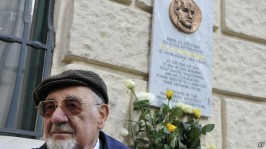by A.L.B. | BUDAPEST
THE last time Gabor Forgacs (pictured) saw Raoul Wallenberg was on January 6th 1945 at number 6 Harmincad street, in downtown Budapest. Wallenberg was a Swedish diplomat, and a scion of a powerful banking family, who saved thousands of Hungarian Jews during the war by issuing them with Swedish papers, placing them under Swedish protection, and intervening at deportation and execution sites. During the war the Swedish diplomatic representation rented the third floor of this building from the Hazai Bank, and Wallenberg turned it into a haven for Jews and a base for his rescue operation. Mr Forgacs, then a teenage boy, was working as a messenger for the Swedes and became Wallenberg’s runner.
Today the imposing stone building on Harmincad street is the site of the British embassy. This morning in Budapest a memorial plaque commemorating Wallenberg was unveiled on the wall of the building. October 15th is an apt date: on this day in 1944 the Arrow Cross took power in Hungary in an SS-aided coup. Wallenberg never considered himself a hero, says Mr Forgacs. These were terrible times: the Arrow Cross ran amok through the besieged city, shooting Jews, men, women and children. The Russians were advancing, raining down shell and mortar fire. Teddy Jobbagy, Wallenberg’s driver, died after being hit here by shrapnel. But Wallenberg went to work every day and did his job. He even kept proper accounts.
Wallenberg may not have thought himself a hero, but he was one, and today’s poignant ceremony helped ensure that the memory of his courage, and that of his helpers, endures. Especially now. In Hungary, like much of Europe, intolerance, racism and xenophobia is on the rise. The far-right Jobbik party, no friend of Hungary’s Jews or Roma minorities, won 16.7 per cent of the vote in April elections, making it the third-largest party in parliament. The British embassy, like numerous EU legations, has taken a strong stand against racism and last year helped launch a campaign, ZARE (Music Against Racism).
Wallenberg was captured by the Russians on January 17th 1945 in Budapest and soon disappeared into the maw of the gulag. His fate remains a mystery. Number 6 Harmincad street, Budapest, is one of the places his memory, and his legacy, lives on.v

